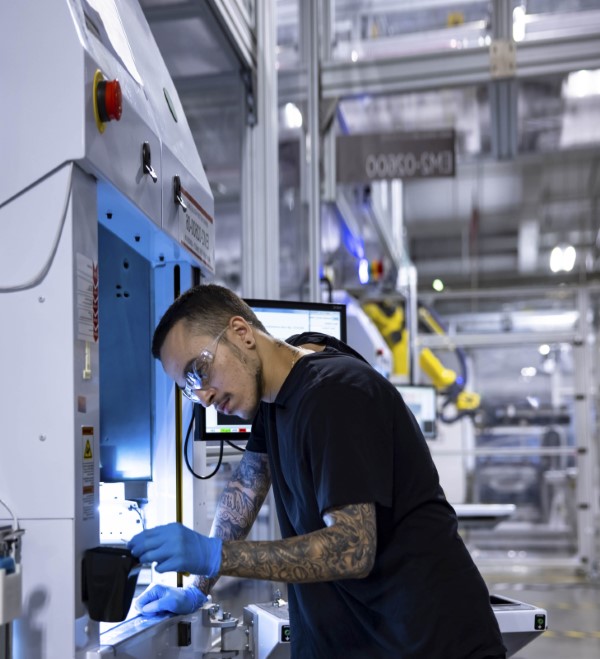When doling out taxpayer dollars under the Biden Administration’s Tech Hubs program, the U.S. Commerce Department is quick to refer to some of the numbers behind its granular vetting process. Of 379 public-private coalitions that formed nationwide to pursue this sliver of federal funding under the CHIPS and Science Act, a mere 31 received Tech Hub designations after an initial knock-out round that concluded in September of 2023. Of those, just 12 were awarded “Phase 2” implementation funding — ranging from $19 million to $51 million — as announced to great fanfare in early July.
On the day of that announcement, Commerce Secretary Gina Raimondo, the deeply invested overseer of the Tech Hubs project, made a beeline for Dragonfly Energy, a lithium-ion battery manufacturer in Reno, Nevada. Yes, Raimondo chose Nevada to trumpet her nationwide initiative, which awarded the maximum $51 million to the Nevada Tech Hub, a clean energy coalition led by the University of Nevada, Reno (UNR) and grounded in the state’s rich deposits of lithium and other strategic minerals and metals.
“The Nevada Tech Hub based in Reno will help make the region a global lithium leader,” Raimondo said, “by bringing together companies, startups, schools, and workforce development organizations — all while boosting economic development and opportunity in northern Nevada and creating new good-paying jobs.”
Formerly considered of questionable value, lithium has emerged as a crucial cog in the clean energy transition, specifically as the essence of the lithium-ion batteries that fuel so many things electric. Operated by North Carolina-based Albemarle, Nevada’s Silver Peak mine is among but a very few active lithium producers in the country. It’s about three hours south of Tesla’s Gigafactory Nevada, which employs around 11,000 people east of Reno. More lithium mines are on the way.
“This is the new oil,” said Dragonfly CEO Denis Phares, speaking not strictly of the silvery-white metal found abundance in Nevada but of the entire “lithium loop,” from extraction to processing, manufacturing and recycling.
“The opportunity to do that here in Nevada is unparalleled,” Phares said at the Tech Hub event. Noting Nevada’s lithium wealth and his company’s 15-year history there, the UNR grad declared that Nevada “turned out to be a really great place to start a battery company,” joking that “I was happy when Tesla saw what I did and copied me and moved here.”
Right Place, Right Time
Dragonfly and Tesla are among the 72 partners that comprise the Nevada Tech Hub, joined by institutions and companies that include UNR, the Governor’s Office of Economic Development (GOED), Panasonic Energy of North America, Agilent Technologies, recycler Redwood Materials and lithium miners ioneer and Lithium Americas. Fred Steinmann, who spearheads the Tech Hub as director of UNR’s University Center of Economic Development, says benefits of the Commerce Department’s endorsement go well beyond the monetary award associated with it.
“The designation of a Tech Hub is very much a signal to the private sector, not just domestically in the United States, but also in partner nations, that ‘here we have a geographic area that’s been identified by the federal government as a unique cluster.’ Since our designation,” Steinmann tells Site Selection, “we have had inquiries and meetings from representatives of Quebec and Ontario. We’ve had inquiries from representatives from the Republic of South Korea, from Abu Dhabi and other nations that are interested in this critical element space.”
Indeed, through its seeding of regional Tech Hubs, the Biden Administration hopes to help propel them to global prominence within their distinct categories, a goal that aligns with Nevada’s efforts to diversify its economy beyond its historic reliance on casino-driven hospitality. The Great Recession of 2008 exposed cracks in that eggs-in-one-basket economic direction. COVID-19 and how Vegas again ground to a halt suggested to state leaders that 2008 might not have been a one-off.
 Tesla’s Gigafactory east of Reno.
Tesla’s Gigafactory east of Reno.
Image courtesy of Tesla
“The clean energy space has been a huge, huge boon to us,” says Bob Potts, GOED’s deputy director. Potts has been involved in strategy sessions going back more than a decade.
“We are one of the largest sources of precious metals going back 150 years,” he says. “That mining infrastructure is already in place. So, on the one end you have all of these extractive opportunities. And now with Tesla and others on the demand side of things, it creates a huge capacity for us to backfill in the middle.”
Founded in Carson City in 2017 by Tesla co-founder J.B. Straubel, Redwood Materials has emerged as a key player within that “lithium loop.” The company pulls critical minerals from end-of-life lithium-ion batteries and funnels them into anode and cathode components essential to the kind of next-generation batteries being made in Nevada. Redwood is creating a system through which battery-grade metals are continuously recycled and reused — reducing the need for new mining and thus supporting sustainability. Its roster of partners includes Toyota, Panasonic, Ford and Volvo.
“All of a sudden,” says Potts, “you have all this stuff converging into the whole energy storage space, all of it hugely complementary.” He says it goes back to the vision of then-Gov. Brian Sandoval, now president of UNR and one of the Tech Hub’s top supporters. Sandoval helped pull stricken Nevada from the Great Recession’s greatest depths and saw clean energy as Nevada’s new thing.
“I’d like to say we were the smartest guys in the room back then,” says Potts, “but a lot of it has been just being in the right place at the right time.”
Continued Support Is Crucial
Federal support for Nevada’s clean energy project doesn’t stop at the Tech Hubs award. In March, the Department of Energy announced a $2.26 billion conditional loan under the Advanced Technology Vehicles Manufacturing Act (ATVM) to support construction of a battery-quality lithium carbonate processing plant at Thacker Pass, along Nevada’s northern border. Further backed by a $650 million equity investment from General Motors, Vancouver-based Lithium Americas is spearheading the project, which includes construction of an open-pit lithium mine launched in June 2023. Lithium Americas says Thacker Pass hosts the largest known lithium resource in North America.
“The United States has an incredible opportunity to lead the next chapter of global electrification in a way that both strengthens our battery supply chains and ensures that the economic benefits are directed toward American workers, companies and communities,” said Jonathan Evans, Lithium Americas’ president and CEO. “The ATVM Loan is a significant milestone for Thacker Pass, which will help meet the growing domestic need for lithium chemicals and strengthen our nation’s security.”
Lithium production at Thacker Pass is expected to reach full capacity by 2028. The project aims to produce enough lithium carbonate to support the production of batteries for up to 800,000 electric vehicles annually. It is expected to create 1,800 jobs during construction and 360 jobs in operations.
Even amid such demonstrable momentum, UNR’s Steinmann, among others, acknowledges that America’s clean energy aims face significant headwinds. He points to the Tesla layoffs announced in May and the worldwide decline in lithium prices. He believes there’s a clear culprit.
“China,” he says, “is flooding the market with batteries and essentially trying to kill the industry before we’ve had a chance to stand it up. It’s very much like OPEC in the ’70s, where a small band of bad actors can make life tough for everyone else.
“But,” Steinmann notes, “the United States is now a net exporter of oil, and the Tech Hubs and the CHIPS and Science Act reflect that learning experience. It’s where you work to break that monopolistic pressure so that private-sector firms like Tesla and Panasonic and Dragonfly can be successful in a truly competitive market.”
In the Strangest of Places
 The Sphere hosts the Dead.
The Sphere hosts the Dead.
Image courtesy of Sphere Entertainment
Danny Newman, a court reporter nearing semi-retirement in Athens, Georgia, can reliably certify that he attended 130 Grateful Dead concerts at venues across the country. And after two recent trips to Las Vegas, 44 shows by successor band Dead & Company. The six Dead shows he saw at the Sphere, the new Vegas landmark and otherworldly 4D entertainment space, were unlike any that Newman has witnessed during his decades of concert-going.
“What I was not expecting,” he recalls, “was how it was virtual reality without goggles. That it could transform you to the desert, to the galaxies, to the ocean, to ancient Egypt. And I’m saying to myself,” he remembers, “‘My gosh, you’re telling me this is not real?’” All to the swirl of the music.
Built at a cost of $2.3 billion — more than Allegiant Stadium, home of the NFL’s Las Vegas Raiders — the Sphere boasts the world’s largest LED screen, spanning 160,000 sq. ft. with 16K resolution. When illuminated, the building’s domed exterior is said to be visible from, yes, space.
U2 sold some 650,000 tickets and grossed more than $200 million during a 40-show run that christened the Sphere beginning last September and accounted for untold room bookings, meals and assorted spending sprees. A sold out, four-show series by the jam band Phish preceded Dead & Company’s 30-concert residency, which moved nearly a half-million tickets from late May into August at an average price of around $400. Max attendance at the Sphere straddles 18,000. The Eagles launch a series of 16 shows beginning September 20.

